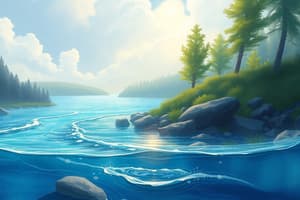Podcast
Questions and Answers
Water sources are not evenly distributed on the Earth's ______.
Water sources are not evenly distributed on the Earth's ______.
surface
Freshwater includes glaciers, rivers, lakes, soil, and ______.
Freshwater includes glaciers, rivers, lakes, soil, and ______.
groundwater
The largest mass of saltwater is the ______.
The largest mass of saltwater is the ______.
Pacific
Water can exist in three states: solid, liquid, and ______.
Water can exist in three states: solid, liquid, and ______.
Sustainable use of resources includes methods like reduce, reuse, recycle, and ______.
Sustainable use of resources includes methods like reduce, reuse, recycle, and ______.
Resource management is affected by culture and ______.
Resource management is affected by culture and ______.
Match the state of water with its description:
Match the state of water with its description:
Match the type of resource management with its focus:
Match the type of resource management with its focus:
Match the type of water source with its characteristic:
Match the type of water source with its characteristic:
Match the sustainable practice with its action:
Match the sustainable practice with its action:
Match the water source with its type:
Match the water source with its type:
Flashcards are hidden until you start studying
Study Notes
Water Sources
- Water is unevenly distributed across the Earth's surface.
- It can transition between different stores, such as from liquid to gas.
- Natural water flows across land contribute to the movement of water.
- Subsurface water is an essential part of Earth's hydrosphere.
Types of Water Sources
-
Freshwater:
- Directly used by humans and ecosystems.
- Sources include glaciers, rivers, lakes, and large ice masses.
- Groundwater and landlocked water bodies also contribute to freshwater availability.
-
Saltwater:
- Comprises oceans, which are interconnected large bodies of water.
- The Pacific Ocean is the largest ocean on Earth.
- Saltwater constitutes a significant portion of the planet's water.
States of Water
- Solid: Water transforms into ice at low temperatures.
- Liquid: Water flows freely, taking the shape of its container without a fixed volume.
- Gas: Water vapor is produced when water boils, resulting in steam.
Resource Management
-
Focuses on ensuring the availability of natural resources for future generations.
-
Sustainable resource use is crucial, which involves:
- Reuse: Utilizing resources multiple times.
- Reduce: Decreasing the amount of resources used.
- Recycle: Processing materials to create new products.
- Recover: Gaining value from waste materials.
- Refuse: Choosing not to use or purchase certain resources.
-
Resource management can be categorized as:
- Human-centered: Prioritizing the extraction of materials for human benefit.
- Nature-centered: Recognizing the intrinsic value of nature and its elements.
-
Resource management is influenced by cultural perspectives and technological advancements.
-
Emphasizes the importance of water and other resources being "useful" for various applications.
States of Water
- Water exists in three states: solid (ice), liquid (water), and gas (steam).
- Solid water freezes at low temperatures, forming ice.
- Liquid water has no fixed volume and flows freely while maintaining a defined shape.
- Gas water boils into steam, expanding in volume.
Water Sources
- Water distribution across Earth's surface is uneven, with movement between different stores.
- Freshwater sources include glaciers, rivers, and lakes, essential for direct human and wildlife consumption.
- Glaciers are large ice masses, while rivers and lakes provide accessible freshwater habitats.
- Saltwater sources are predominantly found in oceans, with the Pacific Ocean being the largest.
- Groundwater is stored beneath Earth's surface, occurring in the soil and within aquifers.
Resource Management
- Two primary approaches to resource management are human-centered, focusing on material benefit, and nature-centered, valuing environmental conservation.
- Effective management is crucial for the availability of natural resources for future generations.
Sustainable Use of Resources
- Five principles guide sustainable resource use:
- Reuse: Utilizing items multiple times before discarding.
- Reduce: Minimizing consumption to lower waste output.
- Recycle: Processing used materials to create new products.
- Recover: Extracting valuable materials from waste.
- Refuse: Choosing not to purchase unnecessary items or resources.
Studying That Suits You
Use AI to generate personalized quizzes and flashcards to suit your learning preferences.




